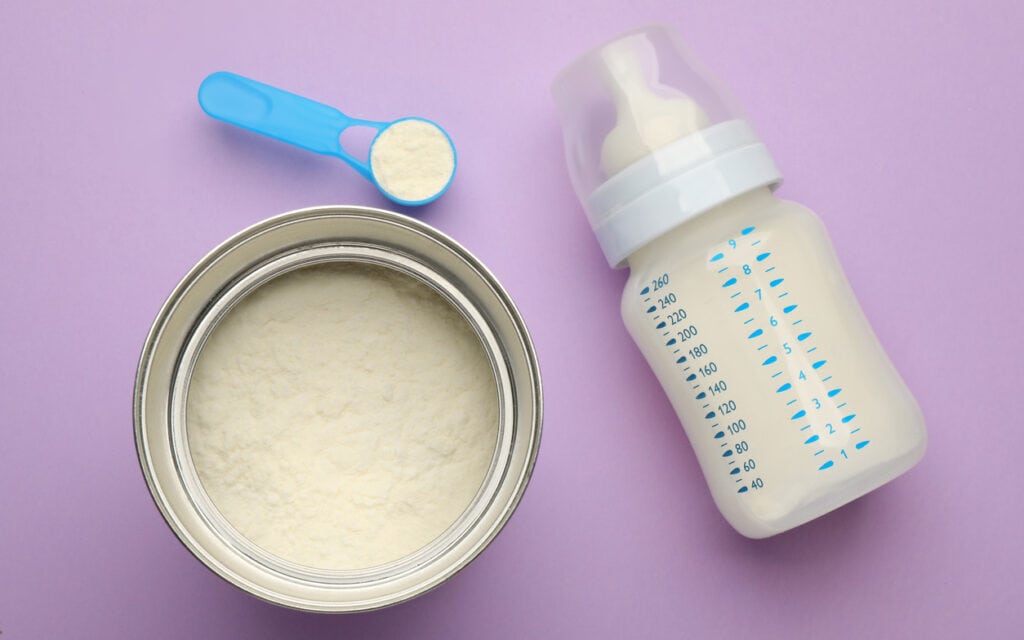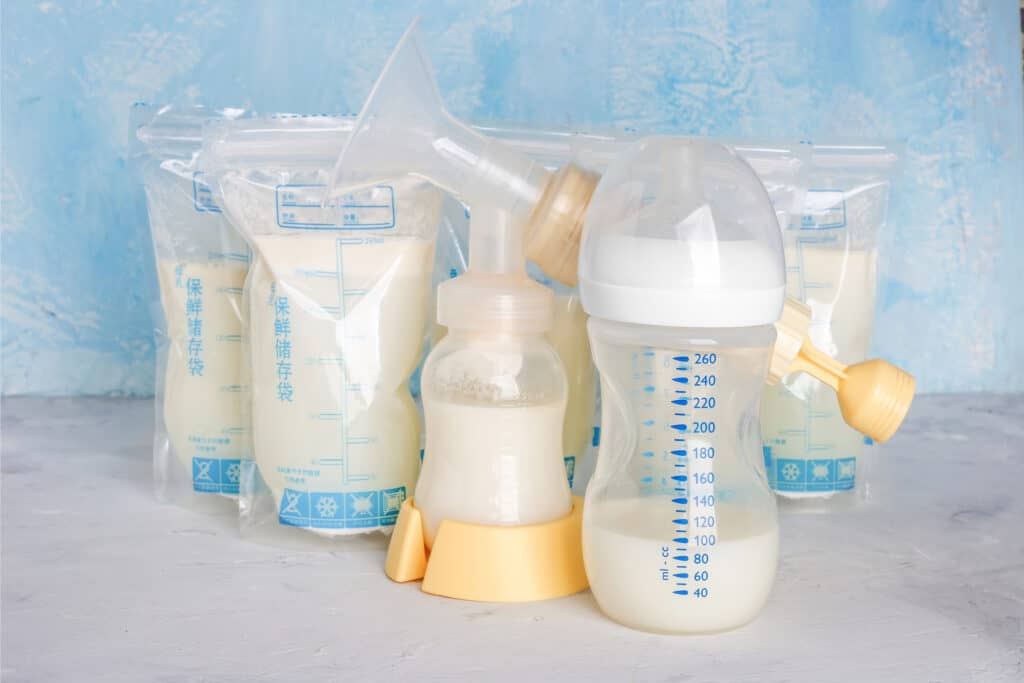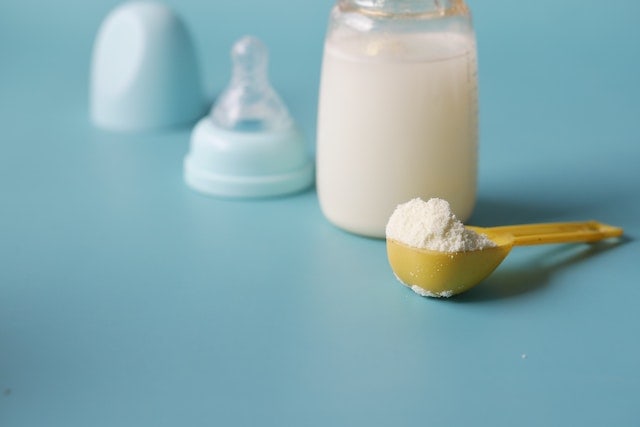Mixing breastmilk and formula is a common practice among parents who want to provide their babies with the best nutrition possible. While breastmilk is considered the gold standard for infant nutrition, formula can be a convenient and reliable alternative when breastfeeding is not an option. However, many parents wonder about the pros and cons of mixing breastmilk and formula and whether it is a safe and effective feeding method.
Understanding Breastmilk and Formula Breastmilk is a complex and dynamic substance that provides optimal nutrition for infants. It contains a unique blend of nutrients, antibodies, and growth factors that support a baby’s immune system, brain development, and overall health. Formula, on the other hand, is a manufactured product that aims to replicate the nutritional composition of breastmilk. It is made from a combination of cow’s milk, vegetable oils, and other ingredients, and can be a suitable alternative when breastmilk is not available.
The Process of Mixing Breastmilk and Formula Mixing breastmilk and formula can be done in various ways, depending on the parent’s preference and the baby’s needs. Some parents choose to alternate between breastmilk and formula feedings, while others mix them together in the same bottle. However, it is important to follow safety guidelines and storage recommendations to prevent contamination and ensure the baby’s health and well-being.
Understanding Breastmilk and Formula
Breastmilk and formula are two sources of nutrition for infants. Breastmilk is often referred to as “liquid gold” due to its nutritional content and benefits for the baby’s immune system. Formula, on the other hand, is a manufactured product that attempts to mimic the nutritional content of breastmilk.

Breastmilk is composed of a complex mixture of nutrients, including proteins, fats, carbohydrates, vitamins, and minerals. The composition of breastmilk changes over time to meet the changing needs of the growing infant. For example, early breastmilk, also known as colostrum, is high in protein and antibodies that help protect the baby’s immune system.
Formula is also composed of a mixture of nutrients, but the composition is fixed and does not change over time. Infant formula is designed to provide the same nutrients as breastmilk, but it may not contain all of the same components. For example, breastmilk contains certain types of fats that are not found in formula.
Breastmilk and formula also differ in the way they are digested. Breastmilk is easily digested by the baby’s digestive system, and it is absorbed quickly into the bloodstream. Formula, on the other hand, may take longer to digest and may not be absorbed as efficiently.
In terms of nutritional content, breastmilk is generally considered to be the best source of nutrition for infants. Breastmilk contains all of the essential nutrients that a baby needs to grow and develop, and it is also rich in antibodies that help protect the baby from infections and illnesses.
However, there are situations where breastfeeding may not be possible or practical. In these cases, formula can be a good alternative source of nutrition for the baby. Formula can also be used to supplement breastfeeding if the mother is not producing enough milk.
Overall, both breastmilk and formula have their pros and cons, and the decision of which to use will depend on the individual needs and circumstances of the mother and baby.
The Process of Mixing Breastmilk and Formula
Mixing breastmilk and formula can be a convenient way to provide a baby with the benefits of both breastmilk and formula. However, it is important to follow the proper steps to ensure that the mixture is safe and provides the appropriate nutrients for the baby.

To mix breastmilk and formula, parents will need a bottle, water, breastmilk, and formula. The water should be boiled and then cooled to room temperature, or parents can use bottled water that is labeled as safe for infant consumption. It is important to measure the water carefully, following the manufacturer’s instructions for the formula.
Parents should then add the appropriate amount of powdered or concentrated formula to the bottle, followed by the measured amount of breastmilk. The mixture should be gently swirled or shaken to ensure that it is well-mixed. It is important to note that ready-to-feed formula should not be mixed with breastmilk, as it has already been mixed to the appropriate concentration.
The temperature of the mixture should be tested before feeding the baby, as it should be at a comfortable temperature for the baby to drink. If the mixture is too warm, parents can run the bottle under cool water or let it sit for a few minutes before feeding. If the mixture is too cold, parents can warm it up by placing it in a bowl of warm water or using a bottle warmer.
Overall, mixing breastmilk and formula can be a safe and convenient way to provide a baby with the benefits of both breastmilk and formula. However, it is important to follow the proper steps and measure carefully to ensure that the mixture is safe and provides the appropriate nutrients for the baby.
Benefits of Mixing Breastmilk and Formula
Mixing breastmilk and formula can provide several benefits for infants, especially for those who are unable to consume enough breastmilk. Here are some of the benefits of mixing breastmilk and formula:
1. Adequate Nutrition
Breastmilk and formula both provide essential nutrients that are necessary for a newborn’s growth and development. However, some mothers may not produce enough breastmilk to meet their baby’s nutritional requirements. In such cases, mixing breastmilk and formula can help ensure that the baby receives adequate nutrition.
2. Health Benefits
Breastmilk contains antibodies that help boost the baby’s immune system and protect them from infections and illnesses. Mixing breastmilk and formula can help provide some of these health benefits to the baby.
3. Calories
Breastmilk contains fewer calories than formula, which can be a concern for premature or underweight babies. Mixing breastmilk and formula can help increase the calorie intake of the baby, which can aid in their growth and development.
4. Digestive System
Formula can be harder to digest than breastmilk, which can lead to digestive issues such as constipation or diarrhea. Mixing breastmilk and formula can help ease the baby’s digestive system and prevent such issues.
Overall, mixing breastmilk and formula can provide several benefits for infants, especially for those who are unable to consume enough breastmilk. However, it is important to consult with a healthcare provider before making any changes to the baby’s diet.
Drawbacks of Mixing Breastmilk and Formula
While mixing breastmilk and formula may seem like a convenient solution for some parents, there are several drawbacks to consider. Here are a few potential issues to keep in mind:
Cons
Mixing breastmilk and formula may lead to some negative consequences. For example, some babies may experience digestive problems, such as gas, constipation, or diarrhea. This is because breastmilk and formula have different nutrient compositions, and mixing them can alter the balance of nutrients that a baby receives. Additionally, some babies may develop allergies or intolerances to certain ingredients in formula, which can be exacerbated by mixing it with breastmilk.
Waste
Mixing breastmilk and formula can also lead to waste. If a baby doesn’t finish a bottle that contains a mixture of breastmilk and formula, the remaining liquid must be discarded. This can be frustrating for parents who are trying to stretch their resources, as breastmilk can be difficult to produce and formula can be expensive.
Shorter Shelf Life
Another drawback of mixing breastmilk and formula is that it can reduce the shelf life of breastmilk. Breastmilk can be stored in the refrigerator for up to five days, but if it is mixed with formula, it must be consumed within 24 hours. This can be challenging for parents who are trying to plan ahead, as they may need to prepare fresh bottles more frequently.
Sterilize
Mixing breastmilk and formula can also make it more difficult to sterilize bottles. Breastmilk can be stored in the refrigerator or freezer without being sterilized, but formula must be prepared with sterile water and in a sterile container. If parents mix breastmilk and formula, they must ensure that the container and nipple are sterilized properly to prevent contamination.
Cost
Finally, mixing breastmilk and formula can be more expensive than exclusively breastfeeding or formula feeding. Breastmilk is free, but formula can be costly, especially if it is consumed frequently. Additionally, if parents are discarding mixed bottles due to waste, they may be throwing away money along with the liquid.
In conclusion, while mixing breastmilk and formula may be a convenient option for some parents, there are several drawbacks to consider. It is important to weigh the pros and cons carefully and make an informed decision based on the needs of the baby and family.
Breastfeeding and Work Commitments
Returning to work after having a baby can be a challenging time for many mothers. One of the biggest concerns for breastfeeding mothers is how to continue breastfeeding while also meeting work commitments.

Breastfeeding mothers who work outside the home may face challenges in maintaining their milk supply and ensuring their baby receives adequate nutrition. However, with proper planning and support, it is possible to continue breastfeeding while working.
One option is to pump breast milk at work and store it for later use. This requires a breast pump and a private space to pump, such as a lactation room or a private office. Many employers are required by law to provide a private space for nursing mothers to pump.
Mothers who choose to pump at work should establish a pumping schedule that works for them and their job. This may involve pumping during breaks or lunch, or adjusting work schedules to allow for pumping sessions.
Another option is to combine breast milk and formula. This can help ensure that the baby receives adequate nutrition while the mother is at work. However, it is important to note that mixing breast milk and formula can have drawbacks, such as a potential reduction in breast milk supply.
Mothers who choose to combine breast milk and formula should do so carefully and under the guidance of a healthcare provider. They should also be aware of the potential risks and benefits of this approach.
Overall, breastfeeding and work commitments can be challenging, but with proper planning and support, it is possible to continue breastfeeding while working. Mothers should work with their employers and healthcare providers to establish a plan that works for them and their baby.
Supplementing Breastmilk with Formula
Supplementing breastmilk with formula is a common practice among mothers who are unable to produce enough milk or need to supplement their baby’s diet with additional nutrients. While it may seem like a simple solution, there are both pros and cons to supplementing breastmilk with formula.
Pros of Supplementing Breastmilk with Formula
- Increased Nutrient Intake: Formula contains additional nutrients that breastmilk may not provide in sufficient quantities, such as vitamin D and iron. Supplementing with formula can help ensure that the baby is receiving all the necessary nutrients for healthy growth and development.
- Increased Milk Supply: Supplementing with formula can help increase milk supply in mothers who are struggling to produce enough milk. The additional stimulation from formula feeding can help increase milk production.
- Convenience: Supplementing with formula can be more convenient for mothers who are unable to breastfeed or pump milk regularly. It allows them to ensure that their baby is receiving adequate nutrition without the need for constant breastfeeding or pumping.
Cons of Supplementing Breastmilk with Formula
- Decreased Breastmilk Production: Supplementing with formula can lead to decreased breastmilk production as the baby may prefer the flow and ease of formula feeding. This can lead to a decrease in milk supply over time.
- Increased Risk of Infection: Formula feeding increases the risk of infection in babies as it does not contain the same antibodies and immune-boosting properties as breastmilk. This can lead to increased instances of ear infections, respiratory infections, and gastrointestinal infections.
- Cost: Formula feeding can be expensive, especially if the baby requires a specialized formula due to allergies or other health concerns. This can be a significant financial burden for families.
Overall, supplementing breastmilk with formula can be a useful tool for mothers who are unable to produce enough milk or need to supplement their baby’s diet with additional nutrients. However, it is important to weigh the pros and cons before making a decision and to consult with a healthcare provider if there are any concerns about milk supply or the baby’s health.
Considerations for Parents and Caregivers
When considering mixing breastmilk and formula, there are several factors that parents and caregivers should take into account. The following are some important considerations to keep in mind:

Breastfeeding Goals
For parents who have a goal of exclusively breastfeeding, it is important to note that introducing formula may impact milk supply. Breastfeeding is a supply-and-demand process, and introducing formula may result in less demand for breastmilk. Parents should also consider the potential impact on the baby’s latch and their willingness to breastfeed after being introduced to formula.
Bottle Feeding
When mixing breastmilk and formula, it is important to ensure that the bottles are properly labeled and that the proportions are consistent across all bottles. This is especially important for caregivers who may not be familiar with the mixing process. Parents should also consider the type of bottles and nipples being used, as some babies may have a preference for certain types.
Newborns
For newborns, it is generally recommended to exclusively breastfeed for the first six months of life. However, some newborns may require supplementation with formula due to medical issues or other factors. Parents should consult with their healthcare provider to determine if supplementing with formula is necessary.
Multiples
Parents of multiples may find it challenging to exclusively breastfeed both babies. In this case, supplementing with formula may be necessary to ensure that both babies are getting enough nutrition. Parents should consult with their healthcare provider to determine the best approach for feeding multiples.
Partner Involvement
When mixing breastmilk and formula, partners can play an important role in the feeding process. It is important for partners to understand the mixing process and to be involved in feeding the baby. This can help to strengthen the bond between the partner and the baby, and can also provide the breastfeeding parent with a break.
Overall, there are both pros and cons to mixing breastmilk and formula. Parents and caregivers should carefully consider their individual circumstances and consult with their healthcare provider to determine the best approach for their baby.
Consulting Healthcare Professionals
When it comes to deciding whether to mix breastmilk and formula, consulting with healthcare professionals can be helpful in making an informed decision.

Pediatricians are a great resource for parents who are considering supplementing with formula. They can provide guidance on how much formula to give, how often to give it, and how it may impact the baby’s growth and development. Additionally, pediatricians can help parents understand the benefits of breastfeeding and how to maintain a healthy breastfeeding relationship while supplementing with formula.
Lactation consultants can also be valuable in this decision-making process. They can provide support and guidance on breastfeeding, including how to increase milk supply if needed. They can also help parents understand how to properly mix breastmilk and formula, as well as how to store and handle breastmilk.
Medical providers, such as nurse practitioners or physician assistants, can also provide guidance on supplementing with formula. They can help parents understand the nutritional content of formula and how it compares to breastmilk. They can also help parents understand any potential risks or side effects of supplementing with formula.
It’s important to remember that every baby is different, and what works for one may not work for another. Consulting with healthcare professionals can help parents make an informed decision that is best for their individual situation.
Potential Health Issues and Solutions
Mixing breastmilk and formula can lead to potential health issues for both the mother and the baby. It is important to be aware of these issues and take necessary precautions to prevent them.
Health Issues
One of the potential health issues that can arise from mixing breastmilk and formula is an increased risk of infection. This is because formula can contain bacteria that may not be present in breastmilk. Additionally, mixing breastmilk and formula can cause the baby’s digestive system to become overloaded, leading to digestive issues such as diarrhea or constipation.
Another potential health issue is mastitis, which is an infection of the breast tissue that can cause pain, swelling, and redness. This can occur when the breasts are not emptied completely, either due to the baby not feeding enough or due to the mother not expressing milk regularly.
Engorgement is another potential issue that can arise from mixing breastmilk and formula. This occurs when the breasts become too full of milk, causing discomfort and pain. This can be prevented by ensuring that the baby is feeding regularly and that the mother is expressing milk as needed.
Breast surgery can also be a potential issue, as it can affect the mother’s ability to produce milk. In some cases, mothers may need to supplement with formula to ensure that their baby is getting enough nutrition.
Solutions
To prevent potential health issues from mixing breastmilk and formula, there are several solutions that can be implemented. First and foremost, it is important to ensure that any formula used is prepared properly and that all equipment used is clean and sterile.
To prevent infections, it is recommended that mothers wash their hands before handling breastmilk or formula, and that they store breastmilk properly to prevent contamination.
To prevent mastitis and engorgement, it is important to ensure that the breasts are emptied completely during feedings. This can be achieved by ensuring that the baby is feeding regularly and by expressing milk as needed.
For mothers who have had breast surgery, it is important to work closely with a lactation consultant to develop a plan for breastfeeding and supplementing with formula as needed.
Overall, while there are potential health issues that can arise from mixing breastmilk and formula, these can be prevented by taking necessary precautions and working closely with healthcare professionals.
Emotional Aspects of Feeding Choices
When it comes to feeding choices, parents may experience a range of emotions, such as guilt, anxiety, and peace of mind. Some parents may feel guilty if they are unable to breastfeed exclusively, while others may feel guilty if they do not supplement with formula. It is important to remember that feeding choices are personal and what works for one family may not work for another.

Parents who choose to mix breastmilk and formula may experience a sense of peace of mind knowing that their baby is receiving the necessary nutrients. This can be especially true for parents who struggle with breastfeeding or have low milk supply. However, some parents may feel anxious about the mixing process or worry that their baby will not receive the full benefits of breastmilk.
It is important for parents to remember that their breastfeeding journey is unique and that supplementing with formula does not mean they have failed. Weaning from breastfeeding can be an emotional process, and parents should seek support if they are struggling with their feeding choices.
Overall, it is important for parents to make informed decisions about feeding choices and to prioritize their own mental health and well-being. By being confident and knowledgeable about their options, parents can make the best choices for their family.
Safety Guidelines and Storage
When it comes to mixing breastmilk and formula, safety guidelines and proper storage are crucial to ensure the health of the baby. Here are some important guidelines to follow:
1. Bottle-Feed
When bottle-feeding, it is important to always use clean bottles and nipples. Before each use, wash them with warm, soapy water and rinse well. Sterilizing the bottles and nipples is also recommended, especially for newborns.
2. Formula-Feeding
When preparing formula, always follow the instructions on the package carefully. Use the correct amount of water and powder to ensure that the baby is getting the right amount of nutrients. It is also important to use clean water, whether from a tap or bottled.
3. Mixing Breastmilk and Formula
When mixing breastmilk and formula, it is recommended to use breastmilk as the base and add the formula to it. This ensures that the baby is getting the benefits of breastmilk while also receiving the extra nutrients from the formula. It is important to mix the two together well to ensure that the baby is getting a consistent blend.
4. Ready-to-Feed Formula
If using ready-to-feed formula, it is important to check the expiration date before giving it to the baby. Once opened, the formula should be used within 48 hours and kept in the refrigerator. It should not be left at room temperature for more than 2 hours.
5. Storage Guidelines
Breastmilk can be stored in the refrigerator for up to 4 days or in the freezer for up to 6 months. It is important to store it in a clean container with a tight-fitting lid. Formula, on the other hand, should be used within 24 hours if stored in the refrigerator and discarded if left at room temperature for more than 2 hours.
In summary, mixing breastmilk and formula can be a safe and convenient option for parents. By following these safety guidelines and proper storage techniques, parents can ensure the health and well-being of their babies.
Conclusion
In conclusion, mixing breastmilk and formula can be a viable option for mothers who are unable to exclusively breastfeed their infants. While breastmilk is considered the best source of nutrition for babies, formula can also provide the necessary nutrients to help them thrive and grow.
It is important to note that breastmilk and formula have different nutritional needs, and mixing them can affect the overall composition of the milk. Mothers should consult with their healthcare provider to determine the appropriate ratio of breastmilk and formula for their baby’s specific needs.
Breastfeeding has been linked to a decreased risk of certain cancers in mothers, as well as promoting bonding between mother and baby. However, mothers who are unable to exclusively breastfeed should not feel guilty or ashamed for supplementing with formula.
Ultimately, the decision to mix breastmilk and formula should be based on the individual needs and circumstances of each mother and baby. With proper guidance and support, mothers can provide their babies with the nutrition they need to finish and extend their development.
Related Post: How to Mix Formula Without Bubbles: A Step-by-Step Guide
Frequently Asked Questions
Can mix feeding cause stomach aches?
Mix feeding can cause stomach aches in some babies. However, it is not a common occurrence. If your baby experiences stomach aches, you may want to adjust the ratio of breast milk to formula or speak to your pediatrician.
How to mix formula and breast milk temperature?
It is important to mix formula and breast milk at the same temperature. You can warm both liquids separately and then mix them together. Alternatively, you can mix them at room temperature.
Does supplementing with formula reduce the benefits of breastfeeding?
Supplementing with formula does not reduce the benefits of breastfeeding. However, exclusive breastfeeding is recommended for the first six months of a baby’s life. Supplementing with formula may decrease milk production, so it is important to breastfeed frequently.
Successful mixed feeding?
Mixed feeding can be successful if done correctly. It is important to maintain a consistent ratio of breast milk to formula and to follow safe storage guidelines. It is also important to monitor your baby’s weight gain and feeding patterns.
Can you mix formula and breastmilk and store in fridge?
Yes, you can mix formula and breast milk and store them in the fridge for up to 24 hours. However, it is important to follow safe storage guidelines and to use the mixture within the recommended time frame.
What are the disadvantages of mixing breastmilk and formula?
Mixing breast milk and formula may lead to confusion for your baby and may decrease milk production. It may also be more expensive than exclusive breastfeeding. However, mixed feeding may be necessary for some families and can be successful if done correctly.

Iesha is a loving mother of 2 beautiful children. She’s an active parent who enjoys indoor and outdoor adventures with her family. Her mission is to share practical and realistic parenting advice to help the parenting community becoming stronger.
